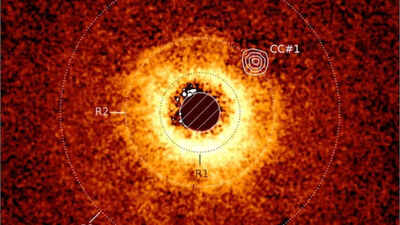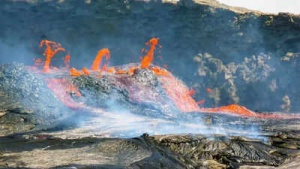The James Webb Space Telescope (JWST) has achieved a significant milestone by directly imaging its first exoplanet after years of dedicated research on known celestial bodies. This newly discovered planet, designated TWA 7b, is a young world that sets a new benchmark as the lowest-mass planet ever directly observed outside our solar system.

With a mass approximately 0.3 times that of Jupiter, or about 100 times the mass of Earth, TWA 7b is significantly lighter than any exoplanet previously captured through direct imaging – about ten times lighter.
The exoplanet orbits a young, low-mass star named CE Antliae (TWA 7), situated approximately 111 light-years away in the constellation Antlia. This star, identified in 1999, belongs to the TW Hydrae Association, a cluster of stars recognized for their relative youth. CE Antliae is estimated to be only 6.4 million years old, a mere infant on a cosmic scale compared to our Sun's 4.6 billion years. Its youthful characteristics and nearly pole-on orientation from Earth render it an ideal subject for JWST's advanced imaging capabilities.
The discovery of TWA 7b hinged on infrared imaging, a technique perfectly suited to JWST's capabilities. Young, low-mass planets emit thermal radiation within the infrared spectrum. JWST's Mid-Infrared Instrument (MIRI), coupled with a coronagraph, was instrumental in this find.
A coronagraph effectively blocks out the intense light emitted by a star, enabling the detection of fainter objects in close proximity, such as exoplanets. By utilizing high-contrast imaging techniques, the JWST team successfully identified a faint infrared signal embedded within the debris disc surrounding TWA 7.
The infrared source was located in a gap between rings of dust, a region hypothesized to be shaped by the gravitational influence of a planet. Simulations validated that a planet with a mass similar to Saturn, positioned in the same location, could account for the observed structure.
The disc encircling TWA 7 exhibits a structured pattern, featuring three distinct rings separated by gaps. One of these gaps contains a narrow ring, flanked by two dust-free zones. This arrangement is commonly associated with the gravitational effects of an orbiting planet. The infrared glow detected by JWST aligns precisely with this ring gap, and its brightness, temperature (approximately 320 Kelvin or 47°C), and orbital distance (around 50 astronomical units from the star) are consistent with the properties expected of a planet in this region.
The discovery of TWA 7b is a landmark achievement in exoplanet science for several key reasons:
Astronomers theorize that the structures observed in debris discs around young stars serve as templates for planetary formation. These rings and gaps represent zones where matter either accumulates to form planets or is cleared out by their gravitational forces. TWA 7b may provide the first direct evidence of this process in action.
Researchers employed sophisticated image subtraction methods to detect TWA 7b. By removing residual starlight, they successfully isolated the planet from background galaxies and other celestial objects. This discovery underscores the capabilities of new observing techniques and instruments aboard JWST, such as the coronagraph and MIRI, in expanding our ability to discover previously inaccessible exoplanets. JWST's mid-infrared sensitivity now allows for the detection of planets as massive and cold as Saturn, a significant improvement in direct imaging.
JWST's ability to suppress starlight and detect the faint heat signatures of small, cold planets opens new avenues for exoplanet discovery. Astronomers are optimistic that even lighter planets, potentially Neptune-mass or even super-Earths, may soon be within reach.
Future observations will focus on:
Newer articles
Older articles
 Moto G54 Gets Significant Price Cut in India, Making Budget Smartphone Even More Appealing
Moto G54 Gets Significant Price Cut in India, Making Budget Smartphone Even More Appealing
 Africa's Rift Valley: Mantle Upwelling Drives Continent's Split and Birth of New Ocean
Africa's Rift Valley: Mantle Upwelling Drives Continent's Split and Birth of New Ocean
 X Cracks Down: Over Half a Million Indian Accounts Suspended for Policy Breaches
X Cracks Down: Over Half a Million Indian Accounts Suspended for Policy Breaches
 Vijay Sethupathi Apologizes Amid Controversy Over Son Surya's Debut Film 'Phoenix'
Vijay Sethupathi Apologizes Amid Controversy Over Son Surya's Debut Film 'Phoenix'
 Jadeja's Accuracy Questioned: Ex-India Pacer Slams Spin Strategy in England Test Loss
Jadeja's Accuracy Questioned: Ex-India Pacer Slams Spin Strategy in England Test Loss
 IRCTC's AI Chatbot Revolutionizes Train Ticket Booking, Refunds, and Information Access
IRCTC's AI Chatbot Revolutionizes Train Ticket Booking, Refunds, and Information Access
 Ashada Gupt Navratri 2025: Unveiling Dates, Sacred Rituals & Hidden Significance of the Monsoon Festival
Ashada Gupt Navratri 2025: Unveiling Dates, Sacred Rituals & Hidden Significance of the Monsoon Festival
 Google Maps Enhances Directional Accuracy with Fused Orientation Provider Update
Google Maps Enhances Directional Accuracy with Fused Orientation Provider Update
 xAI to Open Source Grok, Democratizing Access to Musk's AI Chatbot
xAI to Open Source Grok, Democratizing Access to Musk's AI Chatbot
 Android Users Urged to Patch Now: Critical Security Flaws Expose Devices to Attacks
Android Users Urged to Patch Now: Critical Security Flaws Expose Devices to Attacks